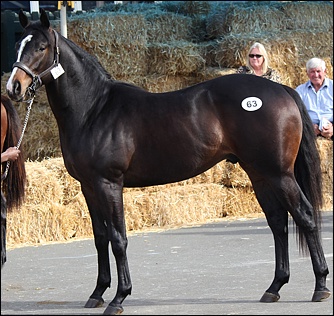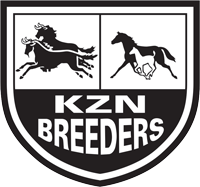| Feeding Yearlings For Sales Prep 05 March, 2012 – Dr Rensia Möller |
The development of the future racehorse starts during pregnancy and the developing foetus (via the late pregnant mare), foal, weanling, and yearling should be fed well before it comes time to embark on intense sales preparation. The job of preparing a yearling is made much easier if one is able to begin with a well-grown horse with a good appetite, condition, and coat.
Preparing a yearling for sale requires correct nutrition, conditioning, grooming, and fitness. Properly prepared yearlings will be fit (not fat), sound, and well-grown with shiny coats. Taking time (longer sales prep times are more beneficial as gradual more natural and not sudden management changes and adaptations can be made) and effort during the preparation can often mean the difference between an adequate yearling and a sale topper. When one prepares a yearling for sale it is important to understand the nutrient requirements of the horse and the critical balance between feed intake and exercise as they greatly impact condition and soundness.
Yearlings do best on a 14-17% protein feed balanced for macro- and micro minerals, water-and fat-soluble vitamins. Feeding rates for yearlings are extremely variable depending on growth history, skeletal size, individual metabolism, actual age, and quality and quantity of roughage. In the preparation of sales yearlings, concentrate feed intakes range from 1-2 kg/day of a supplement balancer pellet up to 7 kg/day of muesli or pelleted hard feed. The best approach is to always feed each yearling as an individual, paying careful attention to body weight, monthly weight gain and body condition score, and adjusting feed intake appropriately accordingly to achieve not maximum but ideal performance growth rates for each individual.
A high-quality, high-energy hay is recommended as foundation for these horses as this will maximize the efficient utilization of fibrous feeds in meeting their energy requirements, and therefore decrease the amount of starch needed in the total diet (high starch can lead to unwanted spikes in growth rates which may negatively affect bone and cartilage development). Using a high-quality, early-cut hay will further help avoid the pot-bellied appearance from gut-fill that is often associated with consumption of a mature hay of high lignin content. However, if you have a short, fat filly that needs to lose weight, rather feed a lower energy grass hay and/or oaten chaff instead of rich lucerne hay.

Beside the base feed, there are a few tools of the trade that fall into the nutrition category. First, and most common, is the use of a supplemental fat source. There are two main reasons to use added fat in the diet: 1) to improve coat condition and 2) to increase energy (for weight gain). The manner in which the supplemental fat is provided comes down to personal choice, but in some instances it may be more practical to top-dress the fat source rather than use a fat-added feed as this will allow more flexibility from horse to horse to correctly adjust growth curves. You can use vegetable oil or oil seeds (sunflower or linseed is most common) to provide the desired calories and fatty acids (a good ratio of omega 3 and 6’s are needed: omega 3 has anti-inflammatory benefits which are helpful in preventing unwanted epiphysitis, and omega 6’s benefit coat condition).
The amount of supplemental fat that is appropriate to use depends on the individual animal. To improve coat quality is relatively simple, and can be achieved with a minimum of 60 ml per day of vegetable oil. Supplemental calories from fat can also be used to reduce the amount of starch that must be fed to achieve a specific energy intake, which is nutritionally safer as there is less starch overflow into the hindgut causing hindgut acidosis and resulting behavioral difficulties and gut discomfort, pre-emptive to colic. When the feed intake reach 5 kg of concentrate feed in the yearling, the advantages of adding supplemental fat should really be considered. Big, rugged, raw-boned yearlings can take as much as 750 ml (3 cups) of vegetable oil per day, which will roughly equal the energy value of 3 kilograms of whole oats. (Gradually adapt and step up fat intake to this level over 28 days and include in small meals often).
In addition to added fat, many prep and show rations will contain super fibers such as soybean hulls and beet pulp. With high concentrate intakes and large meals, as mentioned prior, there is a real possibility of starch-overload diarrhea, colic, laminitis, and behavior problems in the yearling. By using super fibers such as beet pulp in the feed, one can reduce the amount of starch that a horse has to consume while maintaining relatively high energy intake levels. These sources of highly digestible fiber are fermented in the hindgut and absorbed as volatile fatty acids, reducing the amount of undigested starch that may enter the hindgut. Hindgut acidosis is common in sales yearlings on high-grain diets. Ad lib hay should be fed and a hindgut buffer can be used as a preventative measure to yearlings showing signs of hindgut acidosis, such as diarrhea, in-appetence and stable vices. Adding 30ml of apple cider vinegar diluted with 30ml of water to each feed at least twice daily will not only lead to longer chewing time and increased saliva production that naturally buffers against unwanted stomach ulcers, but will also benefit coat quality greatly.
Exercise programs should be similarly tailored to the individual. It is critical to understand that fit and fat are not the same, and that a lot of feed without an increase in the work program results in a horse with a patchy distribution of fat cover and who is more prone to disorders such as colic, laminitis, physitis, and behavior problems.
Obviously, there are many tricks of the trade for getting a well-grown yearling to the sales ring, but the important thing is to design a program and stick to it. Modifications may be necessary along the way to suit individual needs, but the critical aspect is daily attention to detail. One should not get caught in the trap of thinking that there is some magical feed ingredient, supplement, or injection that is going to turn a sow’s ear into a silk purse. Quality genetics, sound nutrition and hard work will more likely pay off and reward in the end. Remember, you are preparing a future athlete, not fattening a lamb for market. Few thoughts to wrap up:
– Longer prep periods are more efficient and safer
– Feed small frequent meals
– Weigh and control roughage intake to avoid pot bellied appearance
– Don’t all of a sudden confine paddock kept yearlings to stables: let out at night and hand walk or walker/treadmill exercise during the day
– Keep walker and treadmill exercise times short and build up gradually – do not overdo on time and speed and unnecessary strain ligaments and open growth plates
– Short gallops of minimum 80m about five times per week have been internationally proven to increase bone density (do not overlook paddock turnout and exercise)
– Horses on high protein pastures and/ being fed high amounts of lucerne hay will do well on a 14% protein ration
– Horses on kikuyu grazing should receive supplemental calcium to counteract the oxalic acid which binds calcium in the kikuyu leaves
– Do not just add balancer pellets and assume all vitamins and minerals are supplied and balanced: consult a knowledgeable equine nutritionist and evaluate total feeding and pasture management and intake regime and balance/adjust accordingly
– Measure horse heights and weights and growth rates and note body condition scores – prevent growth spikes and grow horses on gradual and consistent growth curves
– OPTIMUM growth rates instead of maximum growth rates prevent bone and cartilage disorders due to glucose peaks and resulting insulin spikes and build stronger athletes for better and longer sustained performance
May your yearlings pass through the sales ring in sweeping triumph and become the future champions you bred, planned, hope, wish and know them to be.
All the best
Rensia Möller

 Dr Rensia Möller Dr Rensia MöllerEquine Veterinarian and International Nutritionist Dr Rensia Möller obtained her Agricultural Science before graduating cum laude for her BScAgric Honours in Equine Nutrition and Genetics. She obtained her Masters in Equine Exercise Physiology and Equine Nutrition at the Onderstepoort Veterinary Faculty before completing her Veterinary Science degree at Onderstepoort cum laude. She opened an equine veterinary and nutrition practice in 2002, as well as developing her own equine nutritional supplement brand in South Africa. She was appointed manager of Zabeel Feedmill in Dubai in 2006 where she custom designed professional performance equine feeds for various internationally acclaimed trainers including Mike de Kock, competing for the Dubai World Cup, with numerous race winners and success stories on these feeds. She also exclusively developed formulas for the world renowned Godolphin and Darley equine racing and breeding houses. She is currently on board the dynamic Epol team, doing part-time consultancies for Epol clients, and passionately formulating and upgrading their range e.g. the newly launched long awaited mueslis and the international add-on of the Mike de Kock racing range. She is also available for private client consultancies. |

